Walruses and manatees are two large, gray, water-dwelling creatures. At first glance, they have a lot in common. Yet, if you take some time to study these creatures, you’ll find that they are not actually that much alike. We are going to show you some of the biggest differences between a manatee vs walrus. By the time we’re finished here, you’ll see just how unique each of the animals is and why you would never see them living in the same place!
Comparing a Manatee and a Walrus
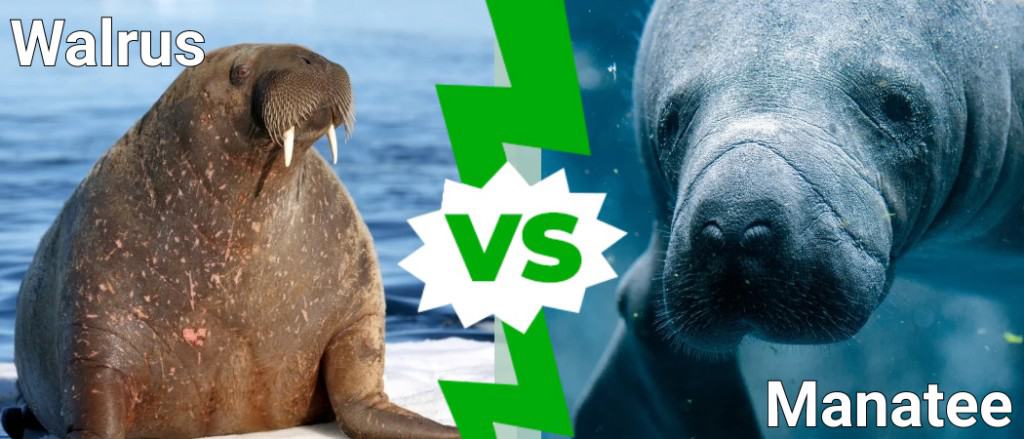
| Manatee | Walrus | |
| Size | Weight: 800lbs 1,200lbs Length: 9-13ft | Weight: 800lbs-3,700lbs Length: 7.5ft-11.5ft |
| Habitat | – Salt water, fresh water, brackish waters – Rivers, oceans, bays, and more – Amazonian Manatee species only lives in fresh water | Ice floes and rocky, remote coastlines in the Arctic and sub-arctic waters |
| Range | – Parts of the U.S., Africa, and Amazon River | – Arctic Circle – Northernmost parts of Russia, the United States, Canada, Greenland, and more. |
| Diet | Herbivore that thrives on sea grass, weeds, algae, and more. | – Carnivore that eats shellfish, squid, snails, fish, and even seals. |
| Teeth | – Six teeth in their cheeks that help manatees chew plant matter. | – 18 teeth – 2 elongated canines that form tusks are used for digging into ice, pulling their bodies out of water, and defense against predators. |
The 5 Key Differences Between a Manatee vs Walrus
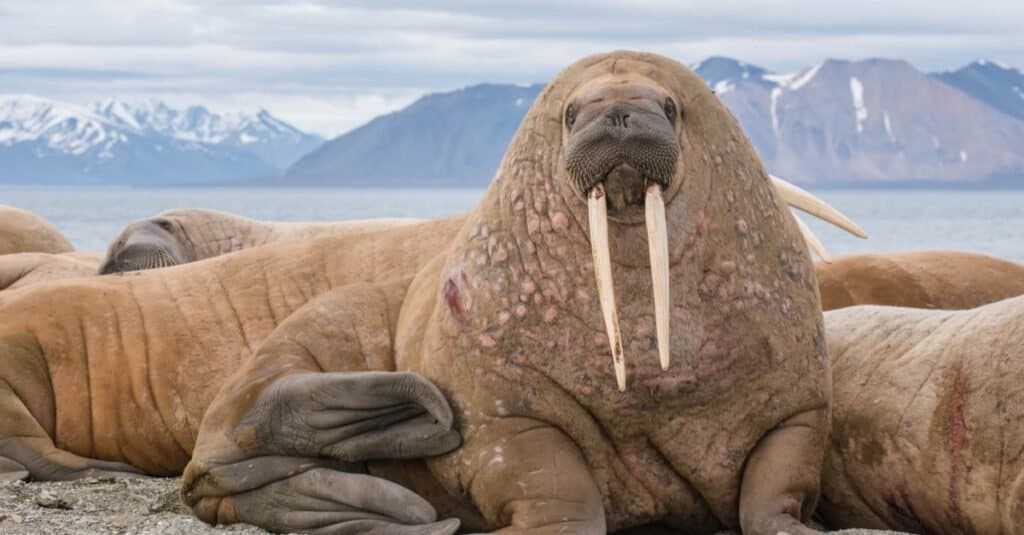
Walruses are larger and heavier than manatees
©Mikhail Cheremkin/Shutterstock.com
The greatest differences between a manatee and a walrus are found in their size, range, and diet. The walrus is much larger than the manatee, weighing over three times as much at the high end of their weight range. Interestingly, the walrus doesn’t grow as long as the manatee.
However, the manatee is found in several unique places around the world such as the United States and surrounding coasts, parts of Africa, and in the Amazon River. Walruses live in the Arctic Circle and in some sub-arctic areas.
Lastly, manatees are herbivores but walruses are carnivores, and that difference in their diet is supported by the unique morphology of their teeth which we will cover in greater detail below.
Manatee vs Walrus: Size
Walruses are bigger than manatees. The average manatee will weigh between 800lbs and 1,200lbs, and they will grow to a length of 13ft at their maximum. Walruses can weigh between 800lbs and 3,700lbs, and they can grow upwards of 11.5ft in length. The walrus is shorter than the manatee, but it has a lot more muscle and fat compared to the manatee.
Part of the reason for their differences in weight can be explained by the places they inhabit around the world.
Manatee vs Walrus: Habitat
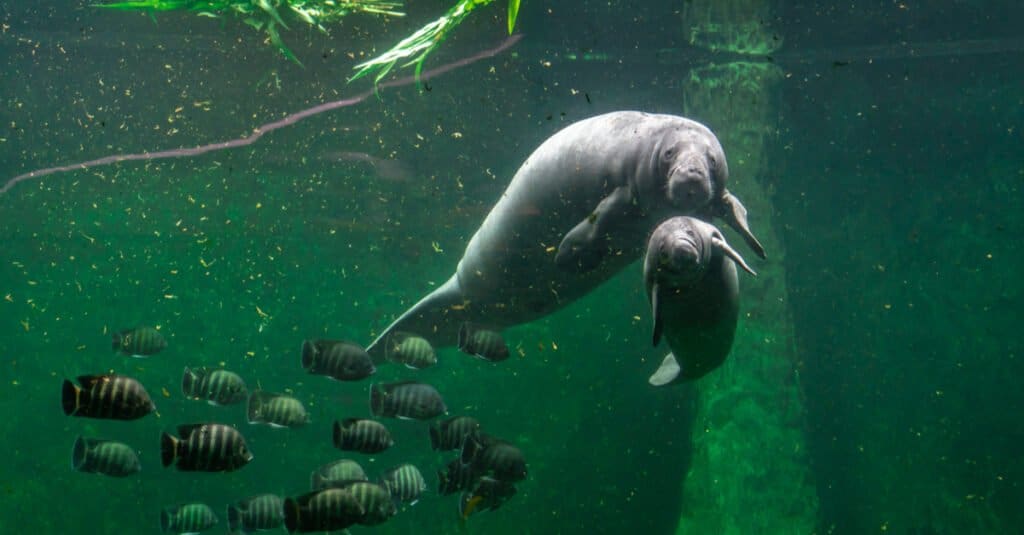
Manatees can live in fresh water or salt water depending on their species.
©Lukasz Machowczyk/Shutterstock.com
Walruses live in some of the coldest places on the planet, while manatees tend to live in warm areas of the world. For example, walruses live on ice floes and on remote coastlines around the Arctic Circle and the sub-Arctic areas directly below them. They live exclusively in salt water areas of the world, though.
Manatees live in salt water, brackish, and fresh water areas. That means they are at home in rivers, oceans bays, and other such areas. However, one species of the manatee exclusively lives in the fresh water of the Amazon River, the Amazonian Manatee.
Although both of these creatures spend significant amount of their lives in the water, the walrus lives exclusively in salt water, but the manatee can live in both depending on the species.
Manatee vs Walrus: Range
The manatee’s range includes several warm areas throughout the world including the U.S., Africa, and the Amazon River. However, walruses live in remote, cold places like Russia, the U.S., Canada, Greenland, and more. They’re spotted living on ice floes on the water or closer to the coast.
The manatee has several different subspecies based on their range. For example, the Amazonian manatee is different from the West Indian manatee, the one that lives in the U.S., in terms of location and preferred water sources. They have actual morphological differences between them.
Yet, the walrus is only split into the Atlantic and Pacific variants. The only differences between them are their locations as well as the foods available to them. Thus, range matters more when discussing manatees than it does with walruses.
Manatee vs Walrus: Diet
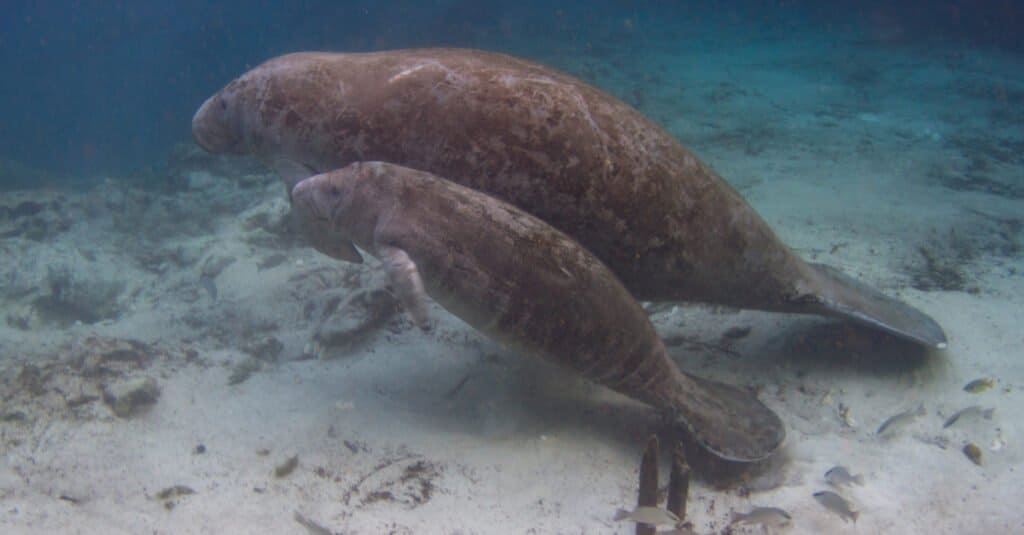
Manatees are herbivores that eat sea grass, algae, and weeds along the banks of water in which they reside.
©Peter Douglas Clark/Shutterstock.com
Manatees are herbivores and walruses are carnivores. The manatee is often called a sea cow, although that name applies to a number of other large, gray, herbivorous, sea-dwelling creatures. The reason for this nickname is that they spend much of their lives grazing for various kinds of food and have plumpness to them that resembles a bovine.
Manatees thrive on sea grass, weeds, algae, and other plant life on the bottom of the sea or near the riverbanks in which they dwell. Walruses are not mistaken for sea cows because they are entirely carnivorous. They eat a wide variety of foods including shellfish, snails, fish, squid, and the occasional seal.
They are opportunistic feeders that will happen across food and consume it in the icy waters they call home.
Manatee vs Walrus: Teeth
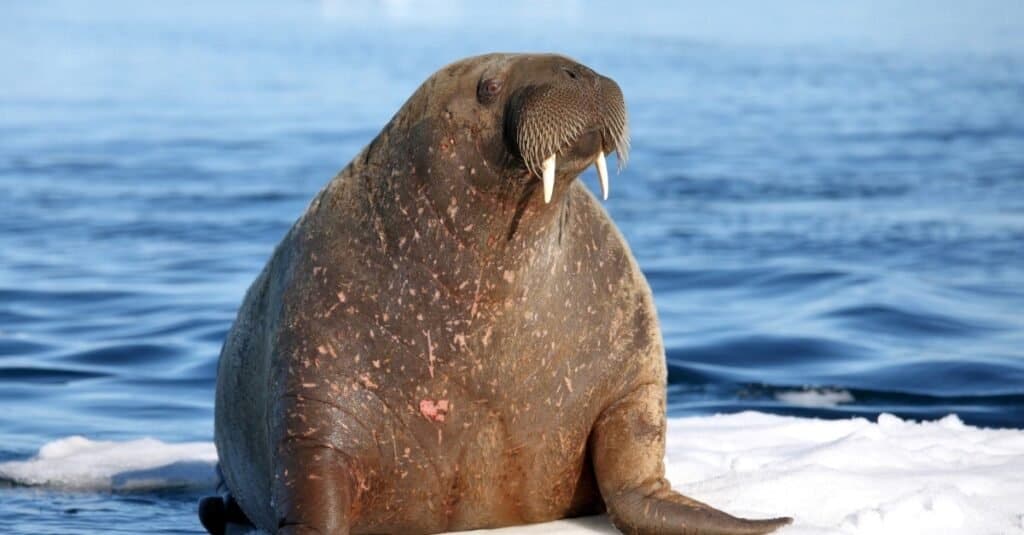
Walrus tusks can grow up to 18 inches long
©iStock.com/zanskar
Manatees have about six teeth tucked away into their cheeks for eating, but walruses have over a dozen teeth, including the massive tusks for which they are well-known. Unlike many herbivores, manatees do not have incisors that help them bite plants. Instead, they have to suck and tear the sea grass out of the silty bottoms of rivers.
Once the food is in their mouths, they have six teeth in their cheeks that can help break down the meal for them to swallow.
Walruses have 18 teeth that help them eat various foods including shellfish. Their two most prominent teeth, their tusks, are massive canine teeth that grow up to 30 inches in length. These teeth have many uses for a walrus. They can be used to drag through the bottom sediments in water to find shellfish or to fend off predators while they’re in the water.
Of course, the walrus’ tusks are very useful for attacking large prey, like seals. These teeth can also be used to help the walrus pull itself out of the water and onto the ice. Walruses teeth are more numerous and useful than a manatee’s.
Walruses and manatees have some similarities, but their difference far outweighs them. Not that it would be possible, but with the information we have presented here, you would be able to tell the difference between these animals if you encountered them in the wild.
The photo featured at the top of this post is © 272007413/Shutterstock.com
Thank you for reading! Have some feedback for us? Contact the AZ Animals editorial team.






